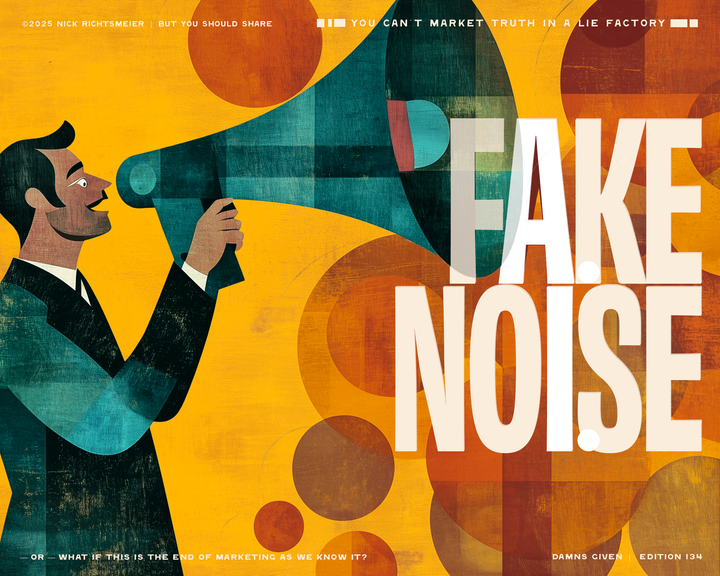Hidden growth killers
Growth killers hide in plain sight. They are often treated as cultural quirks. And in many cases when I’ve challenged about them, the leaders treat them as isolated problems or communication breakdowns, not systemic issues. Willful blindness feels good, but it doesn’t make growth.

When you open up FWD each week, you get my unfiltered, sometimes unfinished thinking. This weekly curation is where I pull together the red threads of what I’m seeing in the trends, what I’m talking to owners about, and—probably most importantly—what’s happening in the gaps.
This is not a tip factory. It would probably get more subscribers if it were, but I’m quite happy with the 1200 or so of us who dwell here. There are enough tip factories.
This is a thinking space.

I’m using it to think about how things connect or don’t and what the unaddressed forces are. I’m asking you to join me in the thinking.
This week, I’m bringing you into a long-standing question—one that I’ve been watching closely in as many places as I can since early last year: Why don’t good things grow?
What makes something good (enough)
We all know sustained growth has prerequisites. Sure, you can go viral like some sort of crappy meme stock that produces no value but its own hype, but that’s not what people who read this newsletter are after. (Definitely not referencing any current events here) Sustained growth, the kind that moves through diverse economic conditions and changes within the business, has set ingredients. When we are invited into a business, and they are missing one of these fundamental things, it's a red flag and probably a sign we won’t work with you:
- A leader with a manageable ego. All leaders have ego. You don’t build something without a strong dose of self-confidence and a small dose of delusions of grandeur. But if the leader cannot see beyond their own perspective, if they are known for submarining anything that isn’t their idea, they will eventually be why a business fails, stagnates, or is sold to a PE for parts.
- Only asks leading questions like “Wouldn’t you agree that....” instead of “I’m not an expert in this, can you please explain it to me?”
- Can’t list their own weaknesses easily and without dramatics.
- Must defend their every action so their intentions are treated as pure.
- Hires weak people they can control and who will make them feel like every good idea was their idea
- A product/service that produces value. We live in a vaporware world where there are many, many products and services that simply slice and dice the economic value of the tech stack in different ways rather than producing real value. One question I always ask of a business is—particularly advisory businesses—with embedded fees: “If you sent your client an invoice and a list of services rendered every quarter, would they pay it?”
- The ability to hire and grow talent. #3 is related to #1 but is distinct. I’ve known many great leaders who simply don’t understand organizational development and talent growth. That’s ok, not all leaders need to do all things. But an organization simply cannot grow if it doesn’t have a repeatable way to bring in skilled people and help them get better at their jobs. The job you hired for will probably last them 12 months max, and then they're going to need to become something else.
If your business lacks one of these things, you either are in stagnation or you’re on fire. It may not feel like that, and you may have a flurry of short-term activity to mask it. But activity means nothing. I spent years working in an environment that confused activity with growth, churning through literally hundreds of employees on their way to stagnation.
If you feel like you meet the prerequisites, you’re in rare air. But you may also be up against a growth ceiling. I’ve seen it over and over. And I’ve been trying to track why. Here’s where the sausage gets made. Let’s dive in:

Hidden growth killers
Below is an unfinished list of hidden growth killers. I’ve compiled the list on some simple rules:
- They have to be recurrent. If it’s a one time problem it doesn’t count.
- They have to be hidden. For example, if you’ve got your pricing model wrong so that you don’t have enough margin to run the business, that’s a big deal, but it’s not a secret.
- They can’t be industry-wide. Some of you are stagnating because your category lost its value proposition or has been commoditized. That’s a big problem, but it doesn’t make this list.
- They can’t be personality-driven. While big and toxic personalities can warp a business around them, there is a singular solution: fire them. It’s hard but its not complicated.
These growth killers hide in plain sight. They are often treated as cultural quirks. And in many cases when I’ve challenged about them, the leaders treat them as isolated problems or communication breakdowns, not systemic issues. That willful blindness feels better in the moment, but it doesn’t make growth.
For those wondering why this is a problem list and not a solution list, let me say this clearly: Your willingness to recognize the problem and treat it as a problem is the solution. There are a billion tactics to work through on all of these. The diagnosis is the challenge.

- Sales-Led Growth: When the customer-facing team are the primary drivers of growth, the business is by definition unstable. Sales leaders are experts in situational persuasion. You can’t build a business on situational expertise. Your go-to-market has to be systemitized and repeatable. In wealth management business, this happens when advisors define the messaging and the growth tactics.
- Chronic Indecision: This is usually masked as “teamwork" where every decision that matters gets shopped around through a dozen or so opinion factories. Responsibility is diffuse because no owns it. Every feels good cause we’re "working together," but decisions are mired in endless review and even supposed finalized decisions get changed in the final hour because some new person chimes in. If you can’t trust people to make decisions until everyone has had their moment to opine, that’s not teamwork or trust, it’s codependence.
- Founder Bottleneck: Here I assume that your founder is not a narcissist. (See above.) But even in orgs with relatively healthy founders, the culture around them can be toxic. A “genius” founder is a dangerous thing where even good ideas get sidelined because “we’ve got to check with Bill.” Along the way, all the great clients are connected to Bill, no one else can solve the big problems, and “vision” is a euphemism for “Bill’s ideas.”
- Marketing Milquetoast: We work with ventures who sell advice and education primarily. These kinds of industries have notoriously terrible marketing resources because historically growth has not been marketing-driven, so the industry talent isn’t there. Now these industries face mass consolidation and commodification and are looking around asking, “what if we did marketing?” They are spending more, hiring agencies, doing brand “stuff”... and most of it is a waste of money. They’re playing wide with conventional strategies that have no tie to their “Unique Good” and instead feel good because “we’re doing marketing stuff now” instead of playing narrow: integrating a highly focused marketing strategy across departments within the firm and toward a very specific target community
- Engineered to Suffocation: Growing firms create execution problems. So they bring in a high-powered COO or they buy a system like EOS. Either of these can be good decisions. But quietly, in a lot of orgs, they are “implementing” at a level of minutia and detail, codifying processes and activities, obsessing over acronyms and systems that are strangling the organization, swinging the pendulum too far. Culture is the tool for blending implementation with vision, and without great culture, a heavy implementation hand will suck the life out a once-vital organization.
Even today as I wrote this, I made notes for a few more that I want to track further. The moral of all of these is that growth resistence is systemic, its cultural, and its almost always tied to decisions that appear to have nothing to do with growth. Once again, making it good and making it grow are often two different sets of decisions. Related, but different.
Resources to go further
This Edition, what we call FWD, your weekly view into my maze of thinking has several sister publications (what we call Editions) :
- MADE: The methods and tools of trust-made growth
- Capital Idea: Breaking the growth stagnation in wealth management
- ***Launching in April*** SMARTS: Addressing growth pain in Higher Education.
To make sure your subscription settings include all the resources you want to receive, you can pick your Editions in our subscribers portal. Add and subtract Editions at your leisure!



